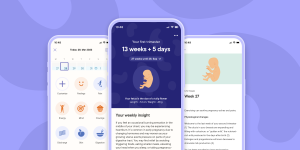Katrin Freidman
Clue report: Reproductive health in 2017
Access and outcomes

We at Clue support universal access to comprehensive healthcare. The economic, social and health benefits of access to comprehensive care are well researched and vast. When we talk about healthcare, we specifically include access to contraception, STI prevention and treatment, pregnancy choices and pre-and postnatal care.
When the United Nations introduced their Millennium Development Goals (quantified targets for improving the lives of the world's poorest people and providing "basic human rights - the rights of each person on the planet to health, education, shelter, and security"), they stipulated that sexual and reproductive freedom was not just a goal in itself, but a prerequisite to all goals. Comprehensive sexual and reproductive health services are necessary to reach the level of top-ranking healthcare countries, where it is safest to be a woman of reproductive age — of any status, economic position, belief system or ethnicity.
The United States spends more of its money on healthcare than any country in the world. Still, its healthcare system ranked 31st in the world by the World Health Organization in 2000. It came last in a 2014 ranking of 11 high-income countries by the Commonwealth Fund. U.S. maternal mortality rates are higher than those of most high-income countries and higher than those of Turkey, Libya and the Republic of Iran (worse than at least 40 countries). The latter is partly due to increasing obesity — an issue which disproportionately affects the same populations with limited access to contraceptives. The U.S. also has the highest rate of teen pregnancy in the industrialized west and the highest rate of infant mortality, ranking as low as 56th in the world.
Access to contraception
For a woman who wants to birth two children, she will spend about three years of her life in a pregnancy-focused reproductive state (trying to become pregnant, being pregnant and postpartum). That leaves over three decades (roughly 400 menstrual cycles) of trying to avoid pregnancy.
U.S. rates of unintended pregnancy (and teen pregnancy) have decreased since 2008. A recent article in the New England Journal of Medicine estimates the rate dropped by about 18% between 2008 and 2012 alone.
Recent reports indicate contraceptive use is likely the key driving force in the declining rates of abortion, teen pregnancy and unintended pregnancy (and their related implications).** But on January 11th, the U.S. Senate made its first major moves in limiting equal access to affordable contraception (and healthcare in general), striking down an amendment requiring insurance companies to cover contraceptive costs. It did the same to an amendment preventing insurance companies from considering pregnancy as a pre existing condition, which would again allow companies to deny coverage on that basis.
Limiting access to contraception means those who can't get it, can't use it. It means more women and teens become pregnant when they don't want to be. More women and teens have avoidable abortions, and have pregnancies and children without insurance. The effects of limiting access fall disproportionately on disadvantaged groups of the population, such as those living below the poverty line. The fallout has vast social, health and economic impacts, individually and nationally.
Removing barriers to contraception also influences what type of contraceptives people choose. In a Missouri simulation of the Affordable Care Act — a project which saw a decline in teen pregnancies of about 80% — nearly 3 in 4 people chose a long-acting-reversible-contraceptive method (LARC), like the IUD or implant, when financial barriers were removed. LARCs have higher success rates than other methods (much higher than condoms or the oral contraceptive pill, as they are typically used) and can last for 3, 5 or more years.
When someone without access to contraceptives has unprotected sex, their next option is emergency contraception. Emergency contraceptive pills (ECPs) work by preventing an egg from being released by the ovary, stopping a possible fertilization. The availability and use of ECPs has been increasing in the U.S. and is likely one part of the decline in unintended pregnancies in women and teens. About half of women who report having used an ECP, did so in a situation where another contraceptive method failed. The FDA has approved the most common type of ECP (Plan B) for over-the-counter sale, without a prescription. Some states continue to push for restricted access of the drug, by limiting its cost coverage and allowing pharmacists to refuse to provide contraceptive services, including ECPs.
When contraceptives fail
**Contraceptive use is a key predictor of whether a woman will have an abortion. **But contraceptive methods, however accessible, can fail. Typical-use failure rate of oral contraceptives is about 1 in 10 and emergency contraceptive pills may be ineffective if taken right around the time of ovulation. One study found more than half of abortion patients reported using a contraceptive method when they became pregnant — 17% reported using hormonal contraception and 27% reported using condoms.
But abortion rates are at a four-decade low. A recent Guttmacher study found the rate declined by 13% between 2008 and 2011 — the same period in which contraceptive access and use increased (the percentage of unintended pregnancies ending in abortion appears to have stayed about same). Analysts found contraceptive use, and the decline in unintended pregnancies it produced, is likely the key factor driving the abortion decline. We may see these stats change slightly after 2011, when several state-level restrictions on abortion were introduced. For those hoping to further limit the number of abortions, increasing access to family planning and modern contraceptives may be the key approach.
There is little data on current rates of unregulated/unsafe abortion in the U.S. It's estimated between 200,000 and 1.2 million illegal abortions took place annually in the U.S., in the decades just before Roe vs. Wade. The number of related deaths is debated, but fell sharply as safe abortion became accessible.
Globally, as stated by the WHO, highly restrictive abortion laws are not associated with lower abortion rates.* Countries with more restrictions have more unregulated, illegal and unsafe abortions. In parallel, they have far higher rates of complications and death. The WHO estimates 20 million illegal and unsafe abortions are performed each year. Complications of these procedures lead to the deaths of about 50,000 women annually and several million more suffer long-term health consequences. The global abortion rate is estimated to be about 1 in 4 pregnancies.
*For example, in Latin America, about 32 in 100 pregnancies are estimated to end in abortion, with a rate of 44 per 1000 women. This is compared to 21 in 100 pregnancies in Western Europe, with a rate of 18 per 1000 women.
On January 24th 2017 the Global Gag Rule was reinstated in an executive order by the new president. This will ban the U.S. from funding international health organizations that provide family planning counselling, including abortion services.
Realities of pregnancy
The United States has the highest rate of teen pregnancy in the industrialized world — about 7 times higher in some cases. Only 13 states currently require sex education to be medically accurate (when provided). Abstinence-based education is still taught and funded in many states, despite accumulating evidence linking it to higher teen pregnancy rates. Abstinence programs received 250 million dollars for the following five years in 2010. At Clue, where most of our millions of users are under 19, we receive hundreds of emails each week from people asking basic questions about their bodies, menstrual cycles, sexual health and possibility of pregnancy.
The overall rate of unintended pregnancy is estimated to be about 45%. The risk of unintended pregnancy falls disproportionately on the same groups with little access to contraception. Those who live below the poverty line have five times more unintended pregnancies than those sitting doubly above the poverty line.
For women who do carry pregnancies in the United States, care is significantly dependant on status and/or access to care. Unintended pregnancies, while difficult to study, are associated with worse outcomes for women and children, in terms of health, finances, social and psychological well-being. A 2015 report by Save the Children found the U.S. had higher maternal death rates than any other industrialized country. The U.S. ranked 33rd for the most advantageous places to be a mother. Of the 25 industrialized capital cities surveyed for infant mortality, Washington D.C. was the worst by a large margin.
In terms of individual costs, an out-of-pocket hospital birth in the U.S. can cost around $10,000. This jumps to about $16,000 for an unplanned cesarean (cesareans account for 1 in 3 U.S. births, more than double the WHO recommendation of "medically necessary"). An uninsured full pregnancy (pre and post) can cost around $30,000. On a broader scale, it's estimated unintended pregnancies cost U.S. taxpayers about $21 billion each year (a 2010 estimate).
When you know better, you can do better
Global health initiatives, including the Gates Foundation's Family Planning 2020 goals and the UN Millennium Development Goals, have prioritized access to family planning services including modern contraceptive tools.
Until comprehensive care is a reality in the United States and around the world, evidence-based health care provision must be prioritized.
Clue supports universal access to comprehensive health services. We're committed to providing accessible evidence-based sexual and reproductive health information. The people who use our app provide researchers with a powerful data set, contributing to the advancement of an understudied field. Internally and with our academic partners, we work to explore and develop new technologies to understand our bodies.




